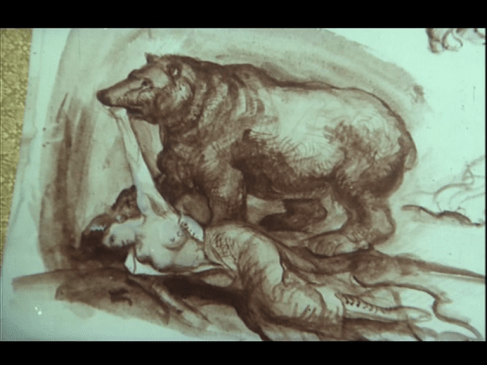Lokis Rękopis profesora Wittembacha (often called simply Lokis) is a 1970 Polish horror film directed by Janusz Majewski. It stars Józef Duriasz, Edmund Fetting, Gustaw Lutkiewicz, Małgorzata Braunek, Zofia Mrozowska and Hanna Stankówna.

An emotionally withdrawn cleric, Professor Wittembach (Edmund Fetting), studying arcane ecclesiastical texts at a remote Lithuanian country house, comes to believe local superstition about his aristocratic young host, the oddly intense Count Michael Szemiot (Józef Duriasz). Rumour has it that the Count, whose mother (Zofia Mrozowska) was mauled by a wild bear during pregnancy, was born only half-human, a possibility that seems more and more compelling as a number of strange events occur in the weeks before the Count’s wedding…
Based on a novella by the French author Prosper Mérimée, this is a carefully crafted piece of work, sombre and brooding, which downplays the more lurid possibilities of its subject and concentrates on character and setting. Thanks to the opulent mansion location and lush surrounding countryside it’s consistently beautiful to watch, and director Janusz Majewski creates a number of striking sequences making full use of the locale, through autumn into winter. The script is devoutly serious and the acting measured and restrained, drawing a handful of hard-to-like but nevertheless interesting characters: Professor Wittembach, whose politeness masks an air of superiority; the misanthropic Doctor Froeber (Gustaw Lutkiewicz), a physician staying at the mansion to care for the Count’s ailing mother; and the Count himself, whose haggard yet piercing eyes brood beneath a permanent frown. Last but not least there’s the Count’s mother, an hysteric locked away in an isolated tower-room, whose screams express a truth pointedly ignored by the urbanity downstairs.
Lokis (the title is a misspelling of the Lithuanian ‘lokys’, meaning “bear”) has much to recommend it to anyone who enjoys the more sober and stately aspects of the Gothic tradition. Gorgeous visuals and sophisticated characterisation aside, however, if Majewski had embraced the genre a little more vigorously the film would be much improved. There is a point in horror cinema at which subtlety shades into diffidence, and Lokis strays beyond it, unwilling to go for the jugular even as the story reaches its climax. At times it feels like the Polish equivalent of a Merchant-Ivory production, with too much time spent observing ladies dancing timorous two-steps, and a wealth of unnecessary chit-chat amid soft furnishings and antique furniture.
This is a shame, because Mérimée’s folk-tale is basically a progenitor for the werewolf sub-genre and a little more wildness would not go amiss. Lurking beneath the elegant surface is a rough-hewn allegory concerning the bestial nature of man versus the sobering force of civilisation. Tension is left to simmer until the very moment when civilisation concedes ‘right of way’ to animal urges – the wedding night. The Count’s inner beastliness is thus unleashed upon his pretty young bride (Malgorzata Braunek, star of Andrzej Zulawski’s The Third Part of the Night), lending the tale a Catholic dimension: such is the woeful power of sexuality that even the sanctified conjugal bed is too weak a vessel to contain it. Of course one may also feel that repression has so distorted the Count’s natural energy that the expression of it leads to destruction and madness. Sex is very much repressed: Doctor Froeber, for instance, shows Wittembach a series of drawings depicting the day the Count’s mother was ‘dragged away’ by a bear, though neither physician nor priest comment on the fact that the drawings have a distinctly erotic dimension, with the bear standing over a supplicant woman whose dress is ripped, exposing her breasts. If only the film had dramatised the encounter!
The erotic subtext is buried so far beneath the genteel surface of Lokis that one longs for an eruption of visual extravagance to match the rage of the were-bear. Instead, on the fateful occasion of the Count’s wedding night, the camera enters the bedchamber only after the damage has been done. Unlike another Polish film on a similar theme, Walerian Borowczyk’s The Beast (1975), the problem with Lokis is that the very repressiveness explored by the story is allowed to afflict the telling of the tale.
Mérimée’s novella, published in the Revue des deux Mondes in September 1869, has much in common with, yet predates, the celebrated antiquarian ghost stories of M. R. James. Mérimée also wrote “Carmen” (1845), used by Bizet as the basis of his celebrated opera. His story “La Vénus d’Ille” (1837) was made into an elegant TV movie by Italian horror maestro Mario Bava in 1979.
Lokis is available on DVD as part of a ‘Horrory’ 3-disc box-set including two more Polish horror films: Wilczyca [‘She-Wolf’] (1982) and Widzaidło [‘Apparition’] (1983).
More information about the film, including translations of contemporary Polish reviews and numerous pictures, can be found at Repozytorium Cyfrowe Filmoteki Narodowej (Digital Repository of the National Film Archive) – go to http://www.repozytorium.fn.org.pl/?q=en/node/8134 Filmoteka Narodowa
Stephen Thrower, moviesandmania
MOVIES & MANIA provides previews, our own film reviews and ratings, plus links to other online reviews from a wide variety of trusted sources in one handy web location. This is a genuinely independent website and we rely solely on the minor income generated by internet ads to pay for web costs and cover yet more movies. Please support us by not blocking ads. Thank you. As an Amazon Associate, we earn a very tiny amount from any qualifying purchases.






